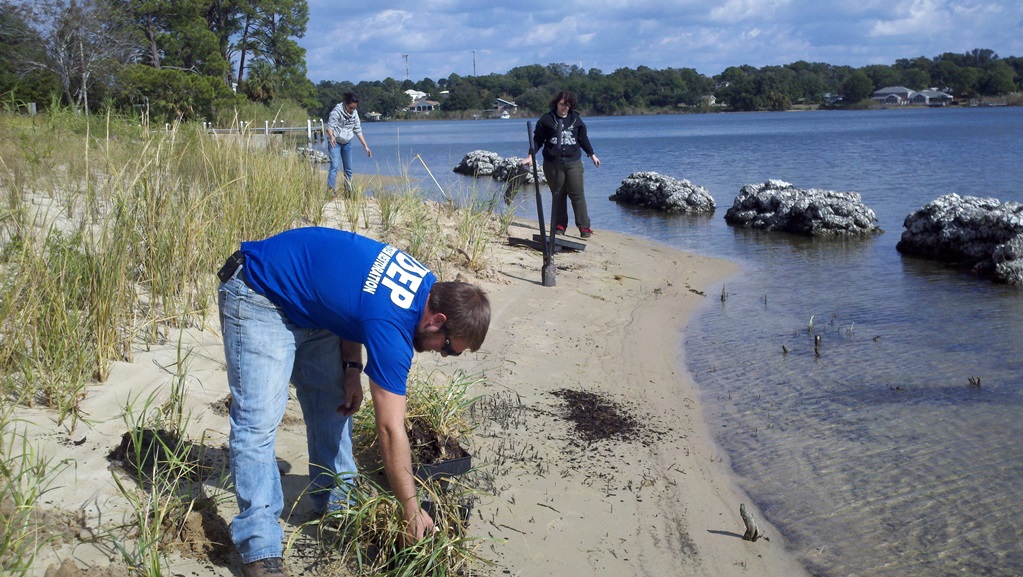
by Rick O'Connor | Sep 25, 2015
In the last edition in this series we discussed some of the issues and problems our estuaries are facing. For the final edition for National Estuaries Week we want to leave you with some ideas on you can help improve things.
The first issue we dealt with was eutrophication – or nutrient overloading. The primary nutrient we have issues with in this part of the panhandle is nitrogen. Nitrates can converted from other forms of nitrogen and can be discharged directly into the water. Common sources are leaf litter, animal waste, commercial fertilizers, and human sewage. Most of this is discharged into our waters via stormwater runoff. This runoff occurs from our properties (due to the lack of natural vegetation holding it) and from stormwater drains (where it is directed through our engineering projects).
One method of dealing with this problem is restoring the shoreline back to its natural state. This is called Living Shorelines and they are being restored all over the country. In most cases locally Living Shorelines would be restoring salt marshes to our shorelines. There are some issues with this. It lessens the amount of open beach you have to enjoy. You have to purchase special plants to do this, and it may require a permit from the state of Florida. Permits are required only if you are planting at or below the mean high tide line; all submerged lands are actually the property of the state of Florida. Permits for Living Shorelines can be obtained from the Florida Department of Environmental Protection.
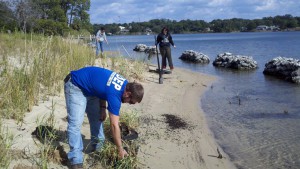
FDEP planting a living shoreline on Bayou Texar in Pensacola.
Photo: FDEP
The first question you would want to ask when considering a Living Shoreline for your property is whether there was a salt marsh along your shore historically. Salt marshes require low energy beaches to establish themselves and your location may not be such. If you are not sure you can contact the Sea Grant Agent in your county to provide assistance with that determination. If you feel your property would support a Living Shoreline then you will need a permit. There is the “long form” and the “short form” permit. The “short form” obviously what you want and it costs less also. However certain criteria must be met in order to be exempt from the “long form”. To determine whether you are exempt from the “long form” visit https://www.flrules.org/gateway/RuleNo.asp?title=ENVIRONMENTAL%20RESOURCE%20PERMITTING&ID=62-330.051 Click “view rule” and scroll down to (12)(e). If you feel that you qualify for the exemption then it is as simple as completing the form and submitting your check. You should have your permit in just a few weeks. If you do not qualify then it is recommended that you contact the Florida Department of Environmental Protection for advice on moving forward. (850) 595-8300.
Whether you qualify for a Living Shoreline or not – or even if you do not live on the water – there is a landscaping program that you can adopt that will help a lot. It is called Florida Friendly Landscaping. This UF/IFAS program helps homeowners select the “right plant for the right place”. Basically the idea is to landscape your yard with native plants that require little or no fertilizing or water. Not only does this program help our estuaries it saves the homeowner money. One of the first things you will want to do when planning a Florida Friendly Landscape is have your soil tested. The county extension office provides this service for about $7. If interested contact your county extension office about where to pick up the soil testing sample bags. Rain barrels and rain gardens are also good ways to reduce water runoff and save water for those times when you might need it. A trickle hose connected to a rain barrel can reduce runoff and your water bill.
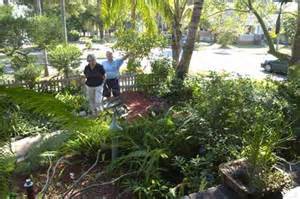
Florida Friendly Landscaping involves using native plants that require less water and fertilizer.
Photo: Southwest Florida Water Management District
We are not certain how much of the animal waste is in fact human but we do know that much of the human waste is from septic tanks. If you have a septic tank – maintain it. Most of the problems come from those that are not maintained well. If you can connect to a sewer line we recommend you do this. The sewer is not without its problems but the problems are much reduced. If you own a pet – clean up behind them.
The leaf litter problem is just that… a problem. Within the city limits many municipalities will collect your yard waste. In Pensacola they do so using a large “claw” however this claw leaves large holes in your yard – so people place the yard waste in the street. Doing this encourages runoff into the bay and the problems we have already discussed. So many will bag it. In Escambia County the yard waste is converted into mulch and is free to the public. However if the yard waste is placed in plastic bags they cannot do this. It’s tough problem. One answer is to develop your own compost pile and dispose of your yard waste there. Your county extension office can help you with different methods of composting and help you select the method that is best for you.
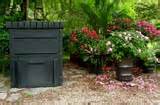
A commercial composting bend that can purchased at many locations or on line.
Photo: UF/IFAS
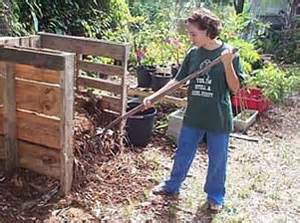
Composting bends can also be made from recycle materials such as pallets.
Photo: UF/IFAS
All of these suggestions about can reduce nutrients and bacteria in our waterways that contribute to fish kills and health advisories. It will reduce turbidity, which will help seagrasses, and actually Living Shorelines can reduce shoreline erosion.
These same practices can not only improve water quality they could help restore some of our declining fisheries. Living Shorelines provide needed habitat for many commercial and recreational valuable species. As mentioned, these projects will remove much of the sediment improving water clarity to a point where seagrasses can restore themselves and who knows… maybe the scallop will return. On the subject of scallops, Florida Sea Grant conducts scallops surveys in some of panhandle estuaries in the summer. You can volunteer to be a scallop surveyor and assist with data collection that could support a scallop restoration projects. When fishing follow the regulations. They may seem unfair and out dated but know that fisheries managers are trying to get it right and your cooperation will certainly help develop a sustainable fishery for years to come.
The issue of garbage is another tough one. We have been conducting educational programs for decades trying to reduce the amount of solid waste – it’s still there. Many of the local residents are pretty good at taking their trash with them and recycling monofilament fishing line… but not all. Encourage your friends to “take it with them” and “leave no trace” when they go home each day. Out of town visitors can be a problem. Local education from all of us should help some. Participate in one of the CleanPeace’s Ocean Hours. If in the Santa Rosa and Escambia area contact the Sea Grant Agents from those counties for more information. If from another county, contact your local county extension office for information on beach clean ups.
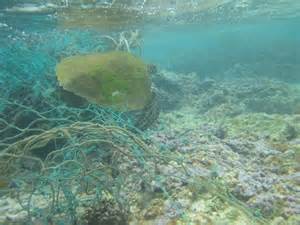
A sea turtle entangled in a discarded fishing net.
Photo: NOAA
Our estuaries have improved significantly from where they were in the late ‘60’s and early 70’s. A little on our part now we can improve them even more. We hope you have learned something new about your local estuary during National Estuaries Week. We hope you will take the time to enjoy these great bodies of water and do what you can to protect for future years.
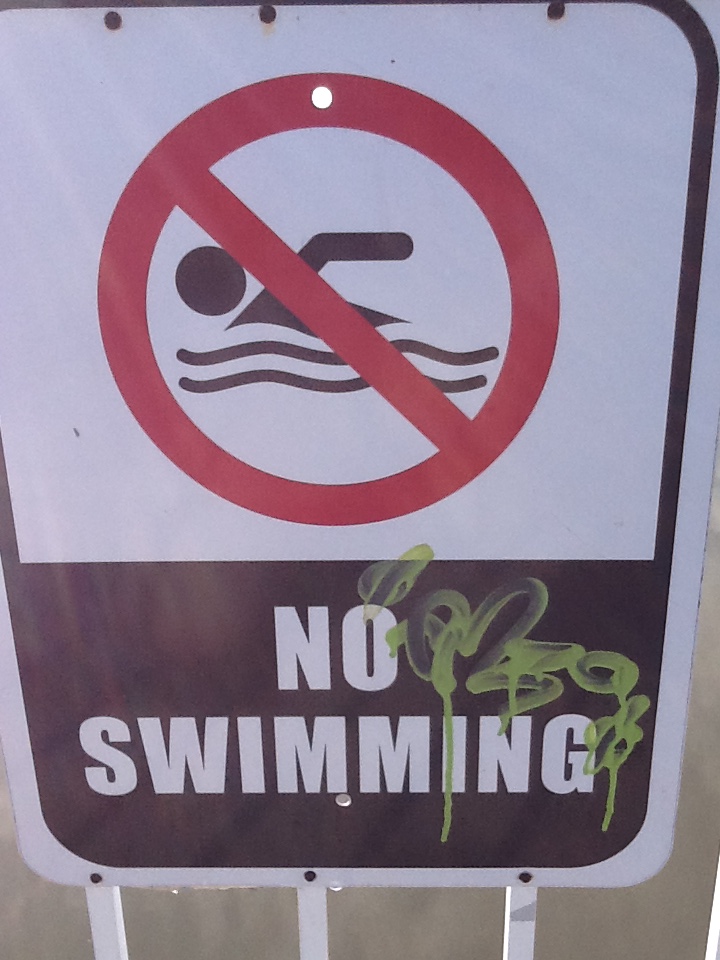
by Rick O'Connor | Sep 24, 2015
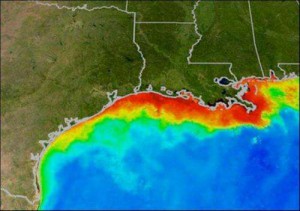
The red area indicates where dissolved oxygen levels are low.
I don’t want this to sound like a “Debbie Downer”… but there are problems with our estuaries and panhandle residents should be aware of them. There are things you can do to correct them – which we will discuss in the final issues of this series – but you need to understand the problem to be able to solve it. Unfortunately there are many issues and problems our bays and bayous face and we do not have time in this short article to discuss them all, but we will discuss some.
We’ll start at the top… with our rivers. Since the founding of our nation many communities were built on estuaries; those that were not were built on the rivers. Water was an easy way to move throughout the country – much easier than wagon crossing over the Appalachians or through a bog. There are several communities that developed along the rivers that feed the panhandle bays. Though the situation has improved in the last few decades, most of these communities have used these rivers as a place to dump their waste. Assorted chemicals, sewage, and solid waste were discharged… and it all came down to us. The Mississippi River is an example of this problem. Discovered in the 1990’s the Louisiana Dead Zone is an area in the Gulf where the levels of dissolved oxygen are so low that little or no life can be found on the ocean floor there. It is believed to be trigger by nutrients, chemical fertilizers and animal waste, being discharged upstream. These nutrients create a bloom of plankton, which can darken the water. Though the phytoplankton can produce oxygen during the daylight hours, they consume it in the evening, lowering the concentration of dissolved oxygen within the water column. The plankton are relatively short lived and eventually die. As the dead plankton fall out to the seafloor bacteria begin to decompose their bodies thus dropping the dissolved oxygen levels further. When the dissolved oxygen concentrations drop below 4.0 millgrams/liter we say the water is hypoxic (low in oxygen). Many species of aquatic organisms begin to stress. At 2.0 mg/L many species will die and we have a “dead zone”. If it reaches 0.0 mg/L we say the water is anoxic (without oxygen). This process is called eutrophication and not only a problem at the mouth of the Mississippi River, it occurs in almost all of the bays and bayous of the panhandle and is the primary cause of local fish kills.
A more recent issue with our rivers has been the reduction of water. In the so called “Water Wars” the state of Georgia has used its damn system to block the flow of the Chattahoochee River to create electricity and a reservoir of drinking water for river communities. Under normal conditions this has not created a problem however in recent years the southeast has experienced drought and the state of Georgia has had the need to hold back water for large communities – such as Atlanta. This has reduced the amount of water flowing towards the Gulf and has impacted communities all along the way. It is not the only issue but is the primary factor triggering the collapse of the oyster industry in Apalachicola. The reduced freshwater flow has increased salinities in the bay. This has disrupted the life cycle of the eastern oyster and has increased both predation and disease within these populations. Apalachicola produces over 90% of Florida’s oysters and 10% of the oysters for the entire country! Oysters are a huge industry in this town. Many are oystermen and many others process the product when it is landed… the industry is on the verge of collapsing. (Learn more).
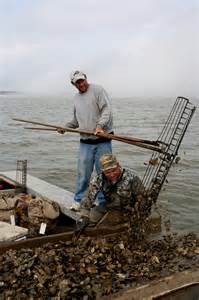
Oysterman on Apalachicola Bay.
Photo: Sea Grant
These are just some the issues stemming from the rivers… what about the issues initiated from the communities that live along the bay…
How about the seafood? We discussed the oyster industry in Apalachicola Bay but oyster production in other local bays has declined as well (for other reasons). Scallops are gone from many of their historic estuaries, shrimp and blue crab landings are down, this year mullet seem to be hard to find. What is going on here? For the most part the decline in seafood products can be tied to either a decline in water quality or from over harvesting. The harvesting issue is easy… do not harvest as much. However these fisheries management decisions impact many lives and has caused a lot of debate. First you need to determine whether the decline is due to overharvesting or some other environmental factor… easier said than done. Certainly the biology of your target species will give you an idea of how many animals you can remove from the system and sustain a healthy population (maximum sustainable yield) but this method has triggered debate as well. Most fishermen do not want to see the fishery collapse and are willing to work with fishery managers to assure this – but they do have bills to pay. Fishery managers have a responsibility to assure the fishery remain for current and future generations of fishermen and they are basing their decisions on the best available science. It is a touchy subject for many and a problem within our estuaries.
The other cause of declining seafood is poor water quality. You can talk to any “ole timer” and they will tell you about the days when the water was clearer, the grass was thicker, and the fish were more abundant… what happen? I spoke with my father-in-law before he passed away about the changes he saw in Bayou Texar in Pensacola. He remembers being able to see the bottom, more seagrass, and being able to catch a variety of finfish as well as shrimp the size of your hand. The first change he remembered was a change in water clarity… it became murkier… and this happen about the time they began to develop the east side of the bayou. As our communities grew more land was cleared for development. The cleared land allowed more runoff to reach the creeks, bayous, and bays. Infrastructure had to be placed to reduce flooding of yards and streets – Bayou Texar has 38 storm drains. All of this led to more runoff into our water ways. With the increase in turbidity the amount of sunlight reaching the bottom was reduced and seagrasses began to decline. Many species of seagrass require salinities of 25 parts per thousand or higher and the increase in freshwater runoff lowered the salinity which also stressed these grasses. Much of this runoff included sand and silt and the grasses were basically buried. All in all seagrasses declined… and with them many of the marine creatures. Salt marshes were removed for coastal developments, industries were located on our rivers and bays and introduced their chemical discharge, and boating activity increased… our estuaries were being literally “loved to death”. I have seen in my lifetime the decline of sea urchins and scallops from our bay, the increase in turbidity, and the decline of seagrasses. But we cannot blame all of this on habitat loss and pollution. Speaking recently with fisheries managers they believe the recent decline in blue crab landings is due to drought. Reduction in rainfall means reduction in river discharge, which means an increase in salinity and a disruption of the crab reproductive cycle.
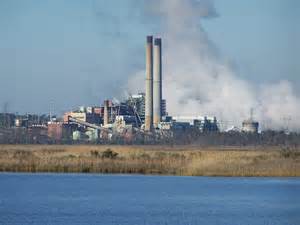
Power plant on one of the panhandle estuaries.
Photo: Flickr
Another problem that is associated with runoff has been the increase in bacteria. Fecal coliform bacteria are found in the stomachs of birds and mammals. They assist with our digestion and are released into the environment whenever we (or they) go to the bathroom. So finding fecal coliforms in the water is not unusual… the problem is TOO many fecal coliforms. As mentioned coliforms are not a threat to us but they are used as an indicator of how much waste is in the water. Feces harbors many other microbes in addition to coliforms – hepatitis and cholera outbreaks have been linked to sewage in the water. So agencies monitor for these each week. Most agencies will monitor for E. coli when sampling freshwater and Enterococcus in saline waters. E. coli values of 800 colonies / 100 milliters of sample or higher, and Enterococcus values of 104 colonies / 100 ml of sample will trigger a health advisory being issued – and some bodies of water being closed. In the Pensacola area the Florida Department of Environmental Protection and the Escambia County Health Department both monitor for bacteria. They post their results each week and I, in turn, post to the community. Our local bayous are averaging between 8-10 advisories each year. The problem with these advisories is that residents who live on the waterways, businesses (such as hotels and ecotours) who use the waterways become concerned about entering the water. It is not good for business or property values if the body of water you are on has high levels of bacteria and signs posting “no swimming”.
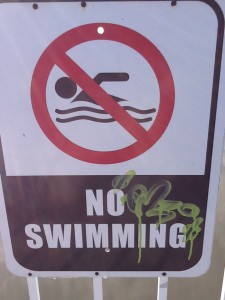
Closed due to bacteria.
Photo: Rick O’Connor
There are many problems our estuaries are facing but for this article we will end with solid waste. Trash and garbage has been a problem since I can remember. Campaigns have been launched each decade to try and reduce the problem but the problem still exist. Plastics and monofilament litter the beaches and waterways creating problems for marine life and an “eye soar” for those enjoying the bay. I am currently working with the Wildlife Sanctuary of Northwest Florida and CleanPeace to monitor solid waste in Pensacola Bay. Each week CleanPeace host a Saturday event they call “Ocean Hour” where they select a location on the bay and clean for an hour. They submit the top three items to me each week and have been doing this since January… it has been pretty consistent… cigarette butts, plastic food wrappers, and plastic drink containers. We are not going to get rid of garbage on our beaches but if we can consistently reduce the “top three” we should be able to reduce the problem.
More on what we can do to help in the final issue.
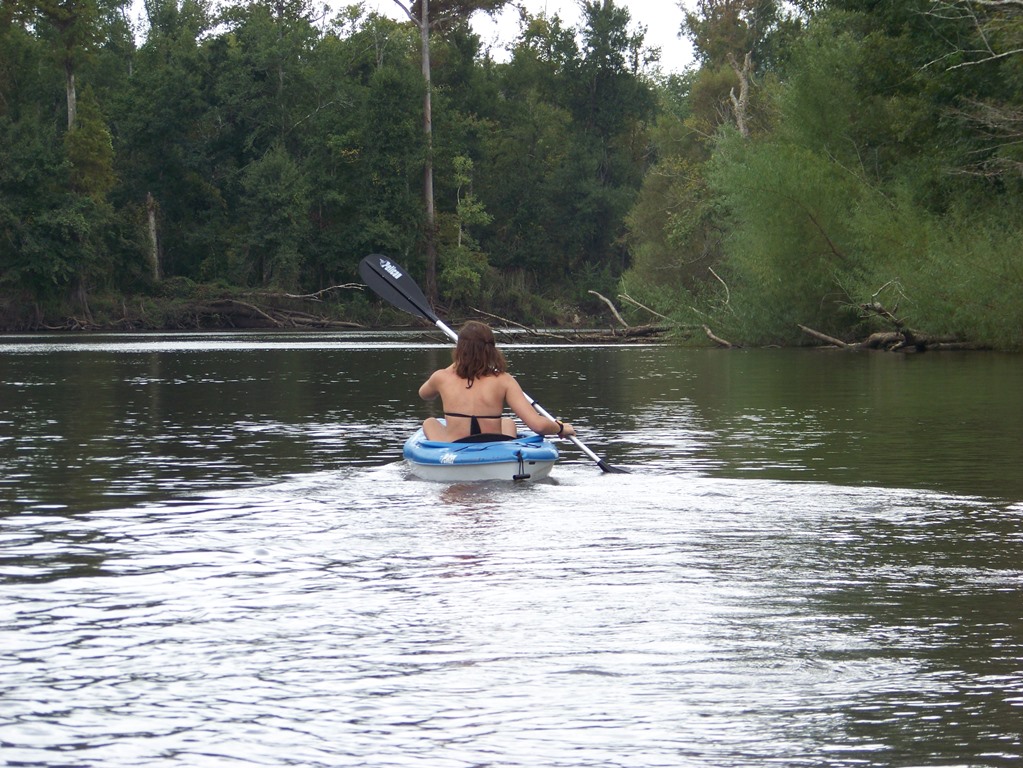
by Rick O'Connor | Sep 21, 2015
A couple of years a few agencies in south Alabama put together something they called the Alabama Birding Trail. It was a relatively simple idea really – they developed a brochure that marked different locations where visitors could enjoy birding in the two county area. They had large signs posted at those locations so that the visitor knew they were at the correct location. There seemed to be a need for this with some vacationers and they provided… It was a big success. More and more visitors were using the trail. It became so popular they that conducted a survey and found that about 40% of the visitors who come to our Gulf coast are looking for outdoor/wildlife adventures to do. Ecotourism is becoming more and more popular.
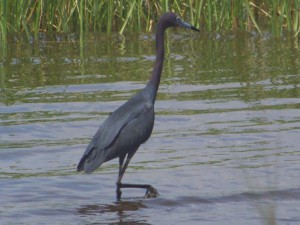
A heron exploring a local salt marsh for food.
Photo: Molly O’Connor
The panhandle is no different. Each year hundreds of thousands to millions of visitors come to our beaches. There is no doubt that we have some of the most beautiful beaches in the world, and they are a huge draw, but we have a lot of outdoor adventures to provide them as well. From scalloping in St. Joe, to snorkeling the jetties in Panama City, to fishing in Destin, to paddling in Navarre, to dolphin cruises in Pensacola the panhandle provides a wide variety of activities for both the local residents and visitors to enjoy – and employment for many.
So what does this have to do with estuaries?
Well, for most of these businesses a healthy wildlife population is needed. A dolphin cruise with no dolphin is not much. Visitors coming to stay on our beaches will certainly enjoy the white sand and emerald waters. They will return home with pictures and stories of how beautiful it was and how they hope to return – but if they saw a sea turtle that week, or went snorkeling and found thousands of tropical fish to view, or kayaked over a lagoon and found horseshoe crabs or stingrays… the stories get better and their urge to return grows. Wildlife and healthy estuaries are good for business – for everyone.
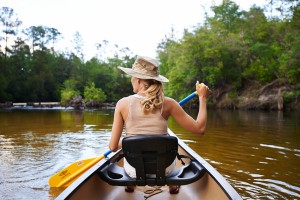
Paddling Blackwater River.
Photo: Adventures Unlimited
In 2014 the Escambia and Santa Rosa county extension offices launched a program called Naturally EscaRosa to help both locals and visitors locate both agritourism and ecotourism businesses in the two county area. The sight provides information on camping, hiking, fishing, sailing, snorkeling, biking, wildlife viewing, and farm tours (of which the popularity is growing across the country). Most of these depend on a healthy bay. Health advisories, fish kills, and loss or degradation of habitat are all problematic for the ecotourism industry. Snorkeling and finding no scallops, paddling over a lagoon and seeing no wildlife, or a slow fishing day on a charter will obviously hurt business – and remember the spin-off’s such as hotels and restaurants as well.
Estuaries have certainly benefitted this industry. From providing a nursery ground for the species we are trying to view or catch, to paddling through a peaceful salt marsh to get away from the hustle and bustle of everyday life, estuaries have been an important part of our lives. And the sunsets… don’t forget the sunsets.
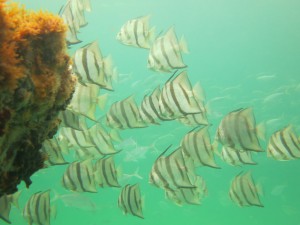
Spadefish on a panhandle snorkel reef.
Photo: Navarre Beach Snorkel
We encourage all locals and visitors to get out and enjoy the beauty of our bays. As the beach season ends the crowds are down, the weather is cooler, and it is a perfect time to venture out. For information about different activities in your area contact your local tourism board, or your county extension office.
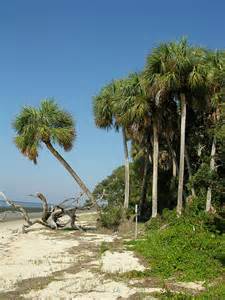
by Rick O'Connor | Aug 7, 2015
First let me explain that Seahorse Key is not in the Florida Panhandle but the story is interesting and a similar phenomena could occur here. Seahorse Key is an isolated island 3.6 miles southwest of Cedar Key in Florida’s Big Bend. There is a science lab owned and maintained by the University of Florida and Captain Kenny McCain on the island but can only reached by boat. Many forms of wildlife, particularly birds, seek out these isolate islands for nesting due to the lack of predators; and Seahorse Key is no exception. Another interesting point about this island is that it may have the highest density of cottonmouths in the state. Dr. Coleman Sheehy has been studying this population and estimates that there may be about 600 cottonmouths on the island. So what is the mystery?
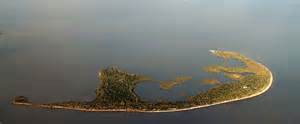
Seahorse Key. An isolated island near Cedar Key
Photo: FMSEA
Well we will first look back to last year and the nesting habits of the island’s birds. In 2014 Vic Doig of the U.S. Fish and Wildlife Service had logged seven different species of egrets, herons, cormorants, pelicans, and ibis nesting on the island. The number of nest per species varied from 100 to 5,000 with the white ibis producing the highest number. Dr. Sheehy surveys the cottonmouths by walking the shoreline and counting the number of snakes he encounters; which is typically around 30. The snakes and nesting birds are concentrated near Gardiners Point. Though the cottonmouths feed on rats they seem to rely on the fish that fall from the nests above.
As 2015 began the biologists noticed something different right off the bat. Though the birds were returning they were not returning in typical numbers, particularly the white ibis. These birds normally are the most abundant nesters on the island, but not this year. Dr. Peter Frederick, University of Florida’s Department of Wildlife Ecology and Conservation, did not seemed to alarmed by this knowing that white ibis are nomadic and do not stick with the same nesting locations for more than a few years. They tend to go where the food is most abundant. No mystery here… Then it happened…
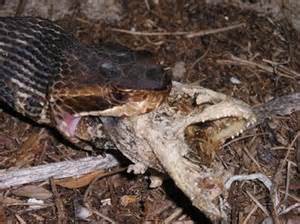
A cottonmouth consuming a fish from a birds nest.
Photo: University of Florida
Within a very short period of time, during the second week of April, all of the other birds began to leave. Researchers found the nests falling apart, no eggs or chicks within them, and hundreds of eggs on the ground. They also found the remains of 26 dead birds in the area. Where had they gone? What had happen?
Autopsied birds found no consistent cause of death. Most of the eggs on the ground had small holes indicating they were preyed upon by birds, most probably fish crows. However these birds are more opportunistic scavengers and would have fed on the eggs only after they had fallen from the nests. Researchers then discovered that many of the birds had relocated to nearby Snake Key. Though they had begun nesting there, fewer than half had done so. All seven species were found there but the number of nests had dropped from 100 – 5,000 to 50 – 600. Many of the birds were still missing. Where did they go? Better yet, why was Snake Key selected and Seahorse abandoned? And did the exodus of birds from Seahorse impact the snakes? The answer is… Yes. Dr. Sheehy’s survey found that the number of snakes encountered along the forest edge had dropped from 30 to 10. He noticed these snakes were thinner and he observed one cottonmouth consuming another, something he had not noticed before. The snakes had been impacted by the decline in nesting birds. What had happened on Seahorse Key?
One idea was put forth by Dr. Sheehy. He had noticed an increase in the number of raccoons on the island. Again, these isolated islands are selected for by nesting birds because of the lack of such predators and Dr. Harvey Lillywhite indicated that the typical number of raccoons on the island is zero. But Dr. Sheehy and Captain McCain had trapped and relocated seven raccoons earlier this summer. This suggests that a large group (large for this island) had found their way to Seahorse Key. Dr. Sheehy suggests that the cause of the movement of birds were the raccoons. There is no evidence of them attacking the birds but they believe the shear presence of the animals was enough for the birds to relocate. However Dr. Fredrick points out that (a) there was little evidence of the raccoons preying on the fallen eggs and (b) he could not find track or scat evidence of more than one or two raccoons on the island during his initial survey after the birds left. He is not so sure the raccoons were the cause.
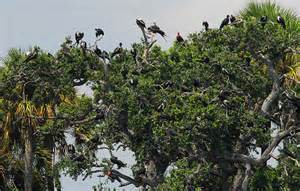
Nesting birds on Seahorse Key
Photo: courtesy of flickr
Then there is the question… Where did the seven raccoons trapped come from? One suggestion was that they were released by locals. This was based on the fact that raccoons captured were well fed and had a mild temperament, not what you typically encounter with trapped raccoons from the wild. Later there was a confirmed report of a local who does take in orphaned raccoons, raises them, and releases them; they could have released some on Seahorse Key – but this has not been confirmed.
So right now this mystery remains unsolved. But the story does indicate the types of problems that can occur when humans relocate animals to habitats they do not typically live in. It takes years for Mother Nature to develop a balance only to have it quickly fall apart by the human release of animals we wish to move or that we think will do better in another location.
You can read more on this story at:
http://fieldguide.blogs.gainesville.com/427/amysteryatseahorsekey/
http://fieldguide.blogs.gainesville.com/450/a-mystery-at-seahorse-key-part-2/
by Judy Biss | Jul 18, 2015
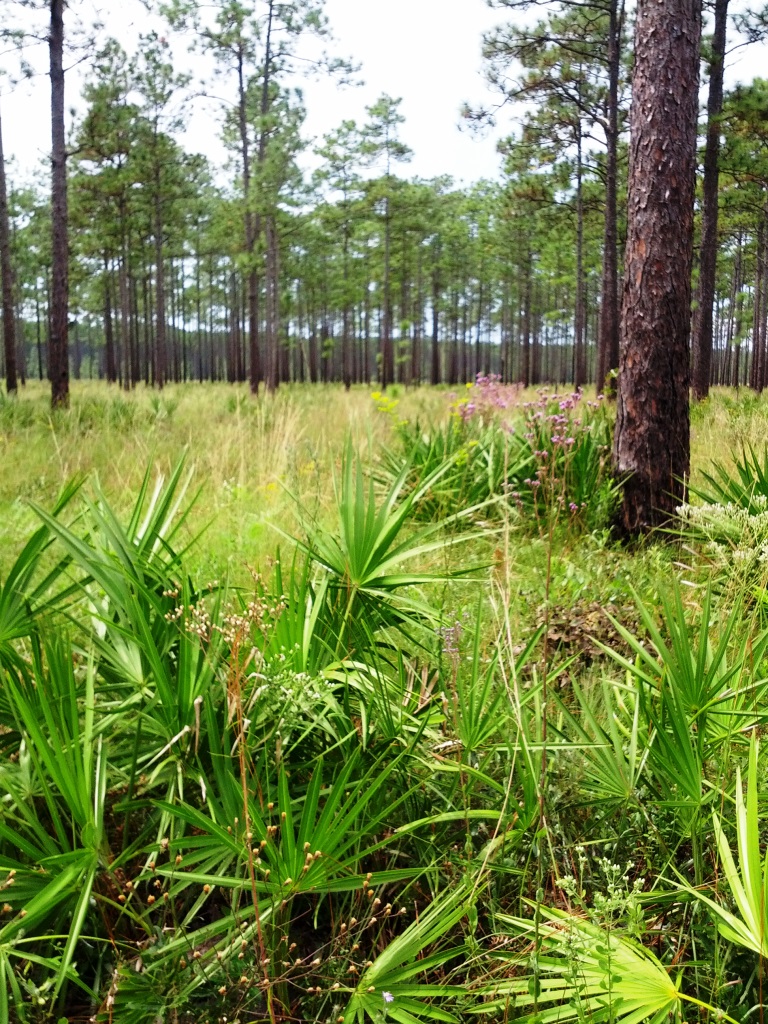
Woodlands and rangelands are important to both our economy and environment. Photo by Judy Ludlow
Most of us living in panhandle Florida recognize that our farmers and ranchers are committed to sustainable production of food, fiber, and fuel for generations to come, but how will farmers continue to be productive while sharing natural resources with an ever growing population and an intricate environment? How will Florida’s agricultural lands, rangelands, and woodlands continue to contribute to the quality of our environment and to our economy?
Florida Rangelands:
According to the USDA Natural Resources Conservation Service “Range and pasture lands are diverse types of land where the primary vegetation produced is herbaceous plants and shrubs. These lands provide forage for beef cattle….and other types of domestic livestock. Also many species of wildlife…depend on these lands for food and cover.” Florida’s rangelands and woodlands are a significant component of Florida’s agricultural industry.
According to the 2012 Census of Agriculture there were:
- 3,749,647 acres of permanent pasture and rangeland in Florida
- 1,368,171 acres of pastured woodland in Florida
Benefits of Rangelands:
Florida’s 5.1 million acres of agricultural rangelands and woodlands not only support the economy, but abundant wildlife too. These well managed lands are living systems sustaining livestock, wildlife, and healthy soils. Benefits of these lands include important economic and ecological services like reducing our carbon footprint, increasing water conservation, providing forage for livestock, habitat for wildlife and game, preservation of cultural heritage, and sustainable timber. Additionally, hunting, fishing, and wildlife viewing is a multi-billion dollar industry within which Florida’s rangelands play a significant role. Florida’s rangelands are also important for the continued survival of many threatened species like the Crested Caracara, Snail Kite, Gopher Tortoise, Florida Scrub-Jay, Eastern Indigo Snake, Roseate Spoonbill, Wood Stork, and Sandhill Cranes.
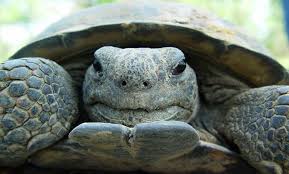
Gopher Tortoise. Photo by Chuck Bargeron, University of Georgia, Bugwood.org
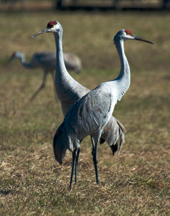
Sandhill Cranes in a North Florida pasture. UF/IFAS Photo by Josh Wickham.
Challenges to Florida’s Rangelands:
Threats to Florida rangelands include conversion into urban areas and fragmentation of large tracts of lands causing disconnection from other farmlands and natural areas. Contiguous, connected “wildlife corridors,” are important for many species of wildlife. Additionally, the establishment of non-native, invasive animals and plants; and alterations of natural and necessary processes such as fire, floods, and droughts, can disrupt the full economic and environmental potential of these lands.
Agricultural Best Management Practices and Education:
Today’s farmers use best management practices (BMPs) relying on up-to-date technologies and research to protect Florida’s unique natural resources, especially our precious water, while at the same time maximizing their production. BMPs are based on University of Florida Institute of Food and Agricultural Sciences (UF/IFAS) research and are practical, cost-effective actions that agricultural producers can take to conserve water and reduce the amount of pesticides, fertilizers, animal waste, and other pollutants entering our water supply. They are designed to benefit water quality and water conservation while maintaining or even enhancing agricultural production. According to the Florida Department of Agriculture and Consumer Services, for example, agricultural producers save 11 billion gallons of water each year by their conservation practices.
Many of Florida’s rangeland and woodland owners also take advantage of educational programs available to them such as the UF/IFAS Forest Stewardship Program. The mission of this multi-agency program is to help and encourage private landowners to manage their lands for long-term environmental, economic, and social benefits. According to their annual report: “In 2014 the Program reached 503 landowners and professionals directly with workshops and field tours. These landowners and professionals collectively own and/or manage over 2 million acres across Florida.”
Summary and Additional Resources:
Florida’s agriculture producers are deeply committed to being stewards of their lands and our surrounding environment. Their adoption and support of best management practices as well as continuing education is critical for sustainable production and also for feeding the world of the future.
For more information on this topic please see the following resources:
UF/IFAS Forest Stewardship Program
UF/IFAS Extension – Range Cattle Research and Education Center
UF/IFAS Extension – Best Management Practices
Florida Farm Bureau’s County Alliance for Responsible Environmental Stewardship Program (This Farm CARES)
Florida Department of Agriculture and Consumer Services – Best Management Practices
The Nature Conservancy – Florida Ranchlands
Food and Agriculture Organization of the United Nations – Grasslands and Rangelands
USDA Natural Resources Conservation Service
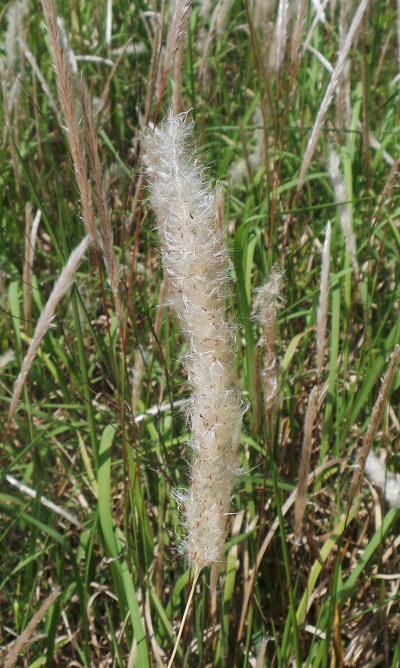
by Mark Mauldin | May 10, 2015
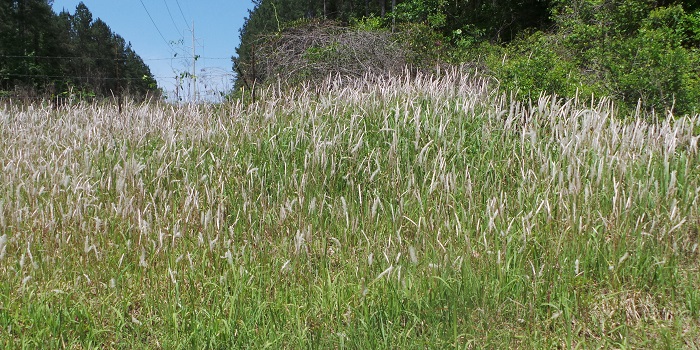
Cogongrass seedheads are easily spotted this time of year.
Photo Credit: Mark Mauldin
We are well into spring and a wide variety of plants are showing off their colorful blooms. As lovely as most of the blooms are, some springtime colors are an unwelcome sight. Such is the case with the showy, white seedhead that is produced by Cogongrass (Imperata cylindrica). The presence of Cogongrass – a highly aggressive, invasive, perennial – in Florida is not news; it has been in Florida since at least the 1930’s. However, the white seedhead that it produces in the spring makes it easier to locate and identify. When the seedhead is not present, the somewhat boring looking grass has the ability to blend in with its surroundings. This makes it harder for un-expecting landowners to identify the new/small infestations which are much easier to eliminate than are larger, well established infestations.

While cogongrass spreads primarily by rhizomes the seedheads can make new infestations easier to find.
Photo Credit: Mark Mauldin
Controlling cogongrass is not easy but it is necessary. If left uncontrolled cogongrass will continue to aggressively spread, displacing other desirable vegetation. Generally speaking, control is a multi-year process. Because the specific recommendations for controlling cogongrass can vary somewhat by situation it is highly advisable that you contact a UF/IFAS Extension Agent in your county if you suspect that you have cogongrass on your property.
The following description of cogongrass from UF/IFAS Center for Aquatic and Invasive Plants should help you identify cogongrass, even if the seedheads are gone.
“Cogongrass is a perennial that varies greatly in appearance. The leaves appear light green, with older leaves becoming orange-brown in color. In areas with killing frosts, the leaves will turn light brown during winter months and present a substantial fire hazard. Cogongrass grows in loose to compact bunches, each ‘bunch’ containing several leaves arising from a central area along a rhizome. The leaves originate directly from ground level and range from one to four feet in length. Each leaf is 1/2 to 3/4 of an inch wide with a prominent, off-center, white mid-rib. The leaf margins are finely serrated; contributing to the undesirable forage qualities of this grass. Seed production predominately occurs in the spring, with long, fluffy-white seedheads. Mowing, burning or fertilization can also induce sporadic seedhead formation. Seeds are extremely small and attached to a plume of long hairs.”
This is the time of year when cogongrass is the easiest to identify. Take advantage of this opportunity to locate new infestations and work with your county agent to develop a control plan. Once a plan is in place, follow it to the end. Stopping after the first year will practically ensure that control will not be achieved.
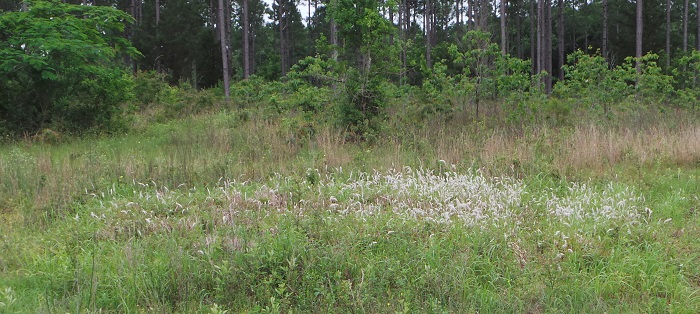
A relatively new patch of cogongrass recently found in Washington County.
Photo Credit: Mark Mauldin
More information on cogongrass can be found by following the links below

























